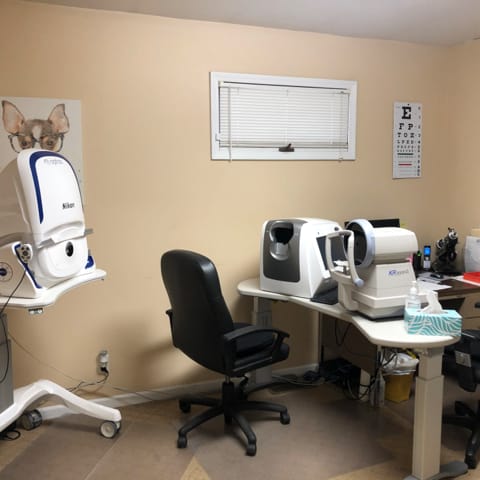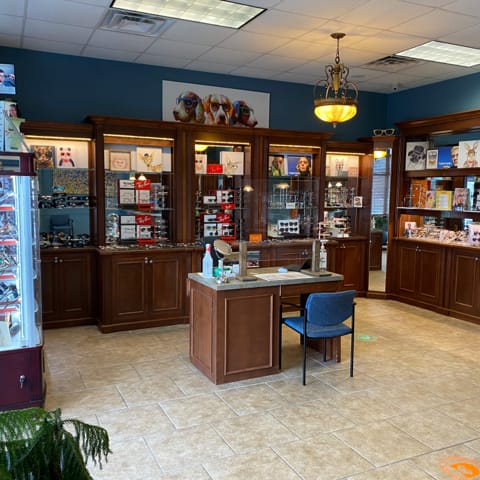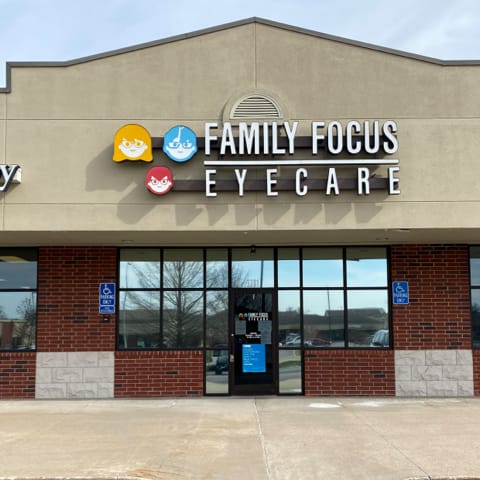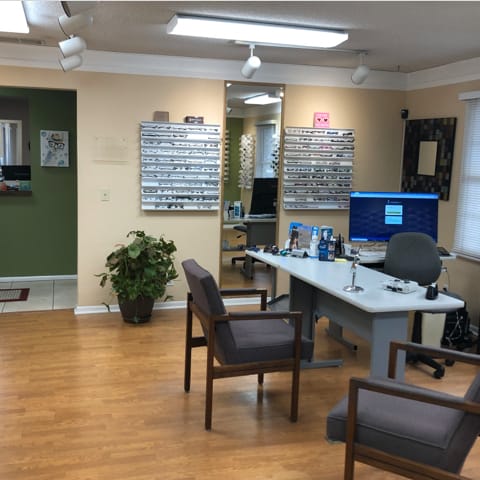Eye Care Is Part of Diabetes Care
Over 34 million Americans have diabetes, and an additional 88 million are considered prediabetic. Considering that about 20% of people first learn they have the disease through a comprehensive eye exam, optometrists are well-positioned to play a role in diabetes management.
People with diabetes should have annual eye exams—and sometimes more often depending on their unique situation. At Family Focus Eyecare, we have the knowledge, experience, and technology to support our patients with diabetes.
We’ll thoroughly examine your eyes, learn about your health history, and make recommendations to help preserve your sight.
Make managing your ocular health a part of your overall diabetes management strategy. Book an appointment for a diabetic eye exam today.

What Is Diabetes?
Diabetes is a chronic condition characterized by high blood sugar. When your body takes in food, a hormone called insulin helps glucose from that food reach your cells and provide energy.
When your body doesn’t make insulin or doesn’t use insulin effectively, glucose stays in the blood instead of reaching your cells. Too much glucose in the blood causes health problems over time, and some of those problems impact your eyes.
Diabetes is always serious, but it can be managed. A healthy diet and plenty of exercise can help maintain your health. And regular eye exams can help maintain your sight.
How Does Diabetes Impact Eyes?
Health problems like kidney disease, nerve damage, stroke, heart disease, and dental issues can all result from diabetes, as well as a variety of ocular conditions.
For adults, diabetes is the leading cause of new cases of blindness. It increases your risk of developing vision-threatening eye diseases, including:
Technology Helps Us Save Your Sight
Family Focus Eyecare invests in the technology necessary to care for diabetic eyes. We examine the impact of diabetes on your ocular health and watch carefully for any changes in your eyes over time.
Fundus Photography
We use fundus photography to take a detailed photograph of the inside back surface of your eye. This area is called the fundus. It’s made up of the retina, macula, optic disc, and retinal blood vessels.
By looking at this area through the pupil, we can watch for diabetic retinopathy or diabetic macular edema signs.
Optical Coherence Tomography (OCT)
Optical coherence tomography (OCT) is an imaging technology that takes a cross-section picture of your retina using light waves. It’s noninvasive and helps us see the various layers of the retina.
Retinal imaging is important in diabetic eye exams. It allows us to watch for changes in the eye’s vascular system that could indicate diabetic eye disease.
Dilated Eye Exams
During a diabetic eye exam, your optometrist will likely dilate your pupils. Dilating (widening) them gives us a larger window to look through and see what’s going on inside your eyes.
Dilating drops are placed in your eyes and, after 20–30 minutes, your eyes will be fully dilated and ready for examination. Your vision might be a little blurry, and you could be sensitive to light following the exam, but this is normal.
Bring sunglasses with you and have someone else drive you to and from the exam. Your eyes will go back to normal after a few hours.
Get a Diabetic Eye Exam
More than half of people with diabetes aren’t routinely following their eye exam schedule. If you have diabetes, make eye care a priority, and please book your appointment today.
Visit One of Our Locations
Columbia
We are in Westbury-1.5 miles further west from our old W. Broadway location, near Toasty Goat and the new Club Carwash
- 725 S. Scott Blvd Suite 101
- Columbia, MO 65203
Our Hours
- Monday: 9:00 AM – 5:00 PM
- Tuesday: 9:00 AM – 5:00 PM
- Wednesday: 9:00 AM – 5:00 PM
- Thursday: 9:00 AM – 5:00 PM
- Friday: 9:00 AM – 5:00 PM
- Saturday: By Appointment
- Sunday: By Appointment
Eldon
Our Eldon location is on Oak Street, two blocks north of the post office and between North and High Street.
- 115 N Oak St
- Eldon, MO 65026
Our Hours
- Monday: 8:30 AM – 5:00 PM
- Tuesday: 8:30 AM – 5:00 PM
- Wednesday: 8:30 AM – 5:00 PM
- Thursday: 8:30 AM – 5:00 PM
- Friday: 8:30 AM – 5:00 PM
- Saturday: By Appointment
- Sunday: By Appointment
Our Brands
View All Brands



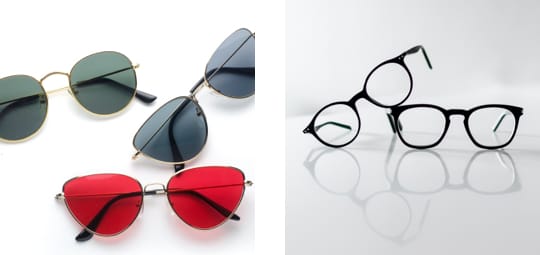

Our Testimonials
Dr. Rich is extremely helpful and thoughtful. He cleared up my eye issues within one appointment and even allowed for texts to assess after the appointment. I had been going to a specialist in Columbia for a year and they didn’t even compare to how great Family Focus Eyecare was!
Erin Scrivner
Dr. Barrett is knowledgeable, friendly and practical, I have gone to her for years and trust her. The office staff is great, they are willing to help and make appointments when you need care quickly.
Pamela Didur
The Family Focus Eyecare team is amazing! They really make you feel like home the second you walk through the door. My husband and I both have been very pleased and highly recommend them to anyone in the Columbia area!
Katie Beasley
Twice now, the staff at FFEC have gone above and beyond to help me see clearly. One time I had a contact lens come out while I was driving. It gave me a migrane, and I drove around in desperation trying to find an eye exam since my prescription was expired…. After being turned away in an EMPTY waiting room at the WalMart vision center, and not even being offered a sample pair till an an appointment could be set… I called FFEC and they not only had me come right over, they squeezed me in between two clients, gave me replacement contacts, and informed me my insurance would cover everything because they looked up my plan details for me!! (I didnt even know I had vision coverage). What an exceptional team and business!!!! I was so thankful. This might be the first review I have ever taken the time to write.
Dorian Brownlee
I had a great experience!! Very knowledgeable staff and excited about the new contact lens options! Highly recommend!
Rhonda Bledsoe
Dr. Rich was so great with our 3 year old son! He was patient and sweet. This was during COVID and they were very careful with masks and cleaning. I plan to go back myself and so does my husband.
Amanda Fisher
I had an acute eye problem and FFE was able to get me in within a few days where other places were months out. They diagnosed the problem quickly and I was on my way feeling relieved that I would soon be headache free.
Kasie Sly
The entire team was friendly, efficient and helpful throughout my entire experience. Best customer service experience I’ve had with an eye doctor in Columbia. I would highly recommend them to anyone.
Sarah Carnes
Best of the best! Very quick and courteous. No wasted time and the prices seem very fair for the services rendered. One of my biggest concerns was picking frames and they made it painless. Very pleased, I recommend them without hesitation!
Steve Baumann
Dr. Rich is by far the best eye doctor I have ever met! They went above and beyond to help me find the right pair of frames for me. I get compliments every time I wear them. No matter where I live I will always see Dr Rich for my eye care. I moved to STL and I still make the 2 hour drive to meet with him – totally worth it.
Walter Juarez
Dr. Rich is fantastic! My last eye exam has been years ago and this is my first visit at Family Focus Eyecare. I was immediately impressed with the attentive staff as you walk in, not only were the friendly but also extremely efficient getting me started and keeping me on time. The lobby area is pleasant and has a nice new feel to it. Because this was my first visit I had to go through the typical tests for them to examine my eyes and their technology & equipment are top-notch, it was so easy. Once I met with Dr. Rich he explained everything clearly and especially took the time to ask me many questions about my eyes, habits, difficulties and things I felt needed his attention. After consulting with him thoroughly and running numerous tests I was given a LOWER prescription! He was able to determine my contacts were too strong and what was causing my vision to not be perfect. Everything about my experience was perfect and I highly recommend Dr. Rich and Family Focus Eyecare!
John Sorensen
The staff is so friendly, helpful and very accommodating for kids. My girls are sad that they only get to go once a year.
Joy Lowe

Our Google Reviews

Our Blog
Does Castor Oil Remove Age Spots?
Dry EyeIPLCastor oil can help lighten age spots, but it’s not the most effective. Learn how IPL therapy can effectively remove age spots with Family Focus Eyecare. […]
Does Screen Time Cause Myopia?
Eye careMyopiaA child with large round glasses sitting on a couch and holding a smartphone very close to his face
[…]
Is Hyaluronic Acid Good for Rosacea?
AestheticsDermatologists often recommend HA to treat rosacea because it can provide moisture for parched skin and, when used as part of a customized skincare routine, may improve your complexion. […]
Does Castor Oil Remove Age Spots?

Castor oil can help lighten age spots, but it’s not the most effective. Learn how IPL therapy can effectively remove age spots with Family Focus Eyecare. […]
Does Screen Time Cause Myopia?

A child with large round glasses sitting on a couch and holding a smartphone very close to his face
[…]
Is Hyaluronic Acid Good for Rosacea?

Dermatologists often recommend HA to treat rosacea because it can provide moisture for parched skin and, when used as part of a customized skincare routine, may improve your complexion. […]






